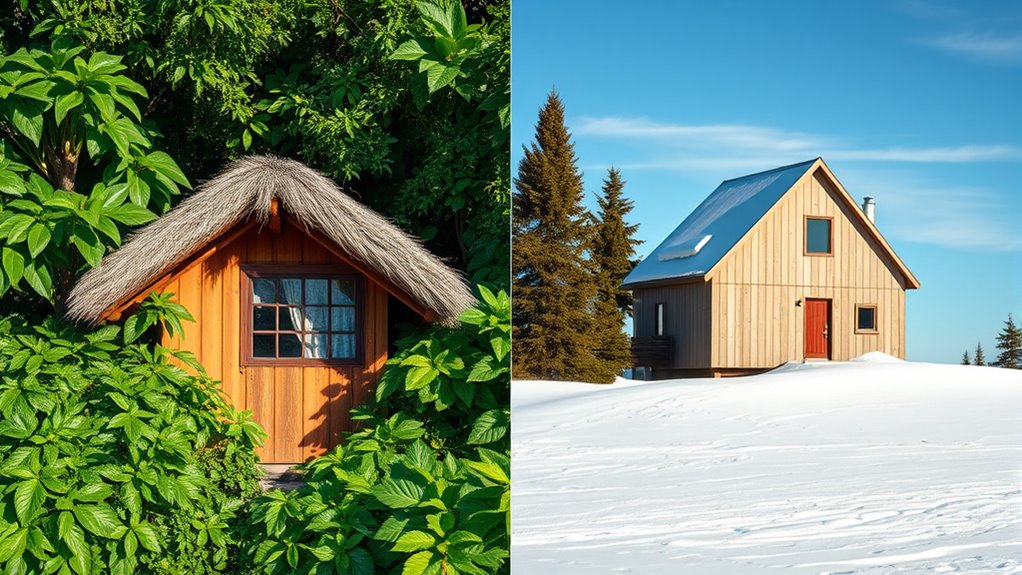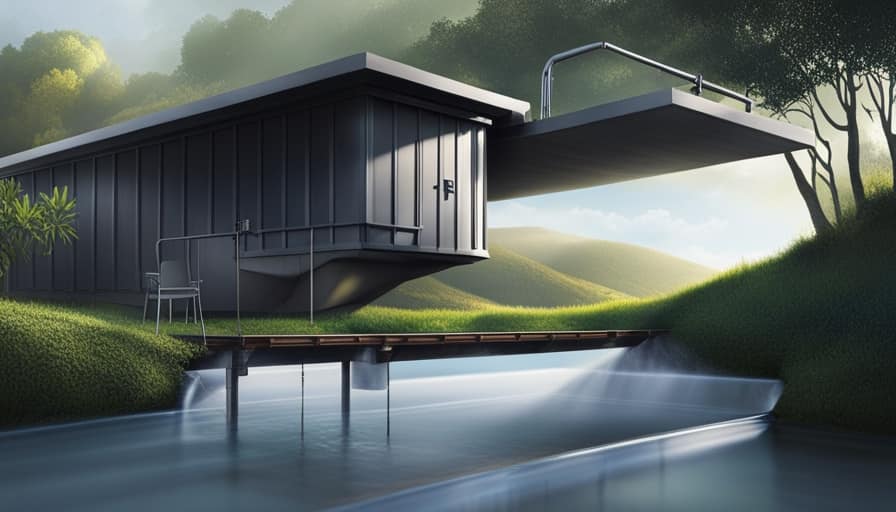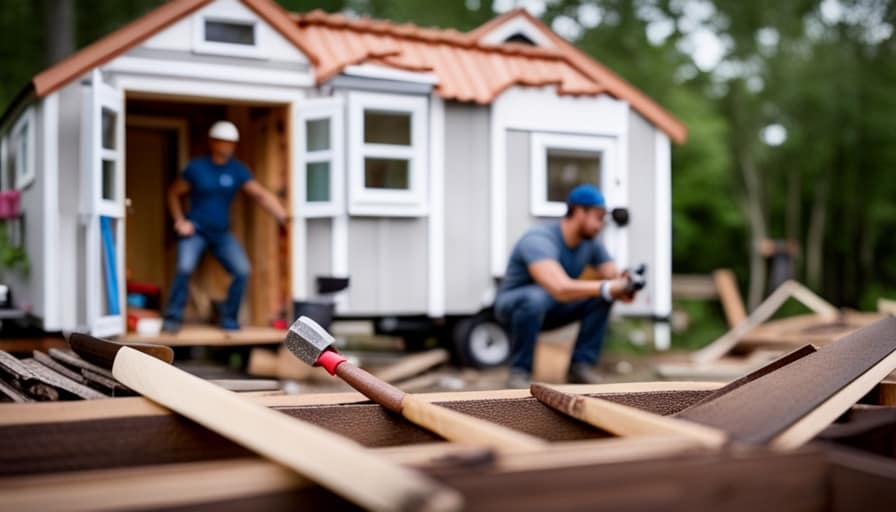When designing tiny homes for the tropics, focus on moisture management, ventilation, shading, and using sustainable, moisture-resistant materials like bamboo and recycled metals. For the tundra, prioritize insulation, durable weather-resistant materials, and robust foundations to combat extreme cold and high winds. Each climate demands unique features to guarantee comfort, longevity, and sustainability. To uncover more specific strategies tailored to these environments, explore further details below.
Key Takeaways
- Tropical tiny houses prioritize moisture management, ventilation, shading, and outdoor integration, using materials like bamboo and rust-proof metals.
- Tundra tiny homes focus on insulation, durable weather-resistant materials, and robust foundations to withstand extreme cold and high winds.
- Tropical designs incorporate passive cooling strategies such as large overhangs and natural ventilation, while tundra homes emphasize high R-value insulation and sealing.
- Climate-specific features include elevated flooring and moisture-resistant siding in the tropics, versus reinforced framing and vented roofs in the tundra.
- Both designs optimize space and energy efficiency by tailoring structure orientation, materials, and passive or active heating/cooling methods to their environments.
Key Design Principles for Tropical Tiny Houses
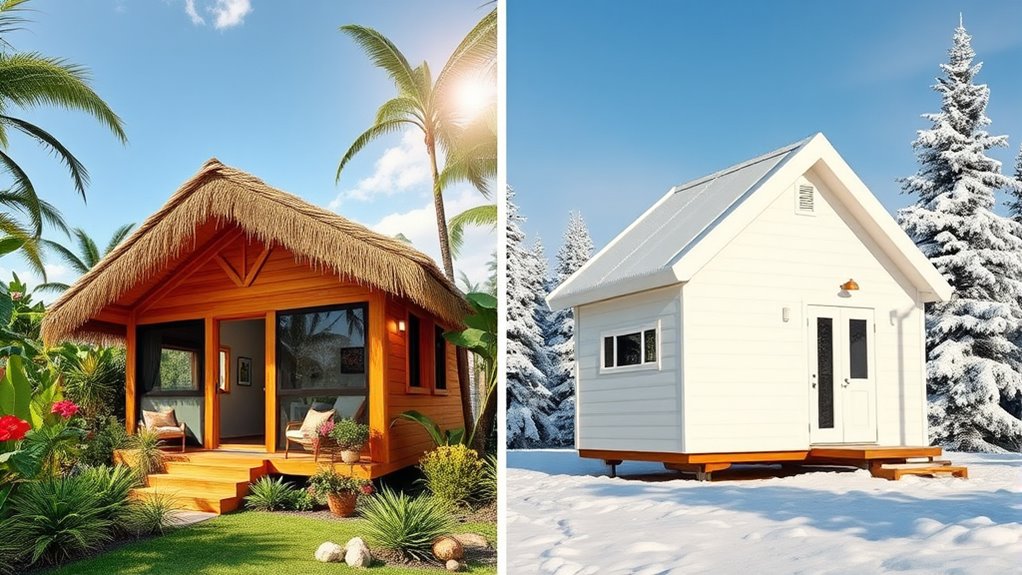
To create efficient tropical tiny houses, you need to prioritize moisture management, ventilation, shading, and outdoor integration. Use moisture-resistant materials like bamboo and rust-proof metals to prevent decay. Apply mold-resistant paints to reduce maintenance and extend lifespan. Incorporate elevated flooring for better air circulation underneath, preventing dampness. Place windows strategically and include louvers to maximize airflow and lower indoor humidity. Align the building orientation with prevailing winds to enhance natural ventilation. Use wide openings such as high windows and shutters on opposite walls for cross ventilation. Incorporate shading elements like overhangs, pergolas, and landscaping to block direct sun and reduce heat gain. Proper design can also reduce energy costs by minimizing the need for mechanical cooling systems. These principles help maintain comfort, durability, and harmony with the tropical climate. Additionally, selecting climate-responsive building materials tailored to the specific environment can further optimize performance and resilience.
Sustainable Materials and Construction Methods in Tropical Environments

You can build tropical tiny houses using locally sourced, sustainable materials like timber, bamboo, and recycled metals to diminish environmental impact. These choices support eco-friendly construction techniques that resist humidity, pests, and storms while maintaining durability. By focusing on regional resources, you guarantee your home blends seamlessly with the environment and promotes long-term sustainability. Using eco-friendly materials reduces waste and energy consumption during construction and maintenance. Incorporating regional construction practices can further enhance the resilience and harmony of your tiny house within its tropical setting.
Locally Sourced Materials
Using locally sourced materials in tropical tiny-house designs offers a sustainable way to reduce environmental impact while enhancing durability. Natural stones like limestone, basalt, and coral stone are ideal, as their heat resistance and porosity help regulate humidity and indoor temperatures, providing passive cooling. These stones also minimize transportation emissions and support sustainable practices, especially when reclaimed or salvaged from demolition sites. Hardwoods such as mahogany, teak, and Gumatj timber are treated for insect, rot, and moisture resistance, extending their lifespan and lowering maintenance needs. Bamboo is a fast-growing, renewable resource that’s strong and versatile, suitable for framing, flooring, and panels. Using locally harvested materials not only minimizes carbon footprint but also bolsters regional economies and promotes environmentally balanced construction tailored to tropical climates. Additionally, advances in machine learning technology are increasingly used to optimize material selection and construction techniques for improved climate resilience and energy efficiency.
Eco-Friendly Building Techniques
Incorporating eco-friendly building techniques in tropical tiny-house designs enhances sustainability while optimizing comfort. You can use passive cooling strategies like large overhangs and shaded windows to reduce reliance on air conditioning. Natural ventilation techniques such as cross-ventilation and stack ventilation harness breezes for airflow. Thermal regulation is achieved through thermal mass, which absorbs and releases heat, maintaining comfortable indoor temperatures. Using materials like bamboo and recycled steel lowers environmental impact, while cool roofing reflects sunlight and reduces heat gain. Additionally, selecting natural materials that are locally sourced can further minimize environmental footprint and promote regional craftsmanship.
Climate-Adapted Features in Arctic Tundra Tiny Houses

To thrive in the harsh Arctic tundra, tiny houses must feature climate-specific adaptations that address extreme cold, heavy snow, and strong winds. You’ll want insulated materials like closed-cell spray foam to boost heat retention and strengthen the structure. Walls should be built with 2x6s or 2x4s for added durability against the elements. Exterior finishes, such as tongue and groove siding, help seal out moisture and prevent warping. The roof needs a vented design to improve airflow and handle snow and ice buildup, while overhangs protect against moisture damage. Reinforced framing withstands high wind loads, and specialized foundations ensure stability on icy ground. Choosing appropriate insulation materials is crucial for maintaining energy efficiency. Proper climate-resilient construction techniques further enhance the tiny house’s durability and comfort in extreme environments. These features work together to keep your tiny home resilient, safe, and comfortable in the extreme Arctic environment.
Energy Efficiency Strategies in Cold-Climate Tiny Homes
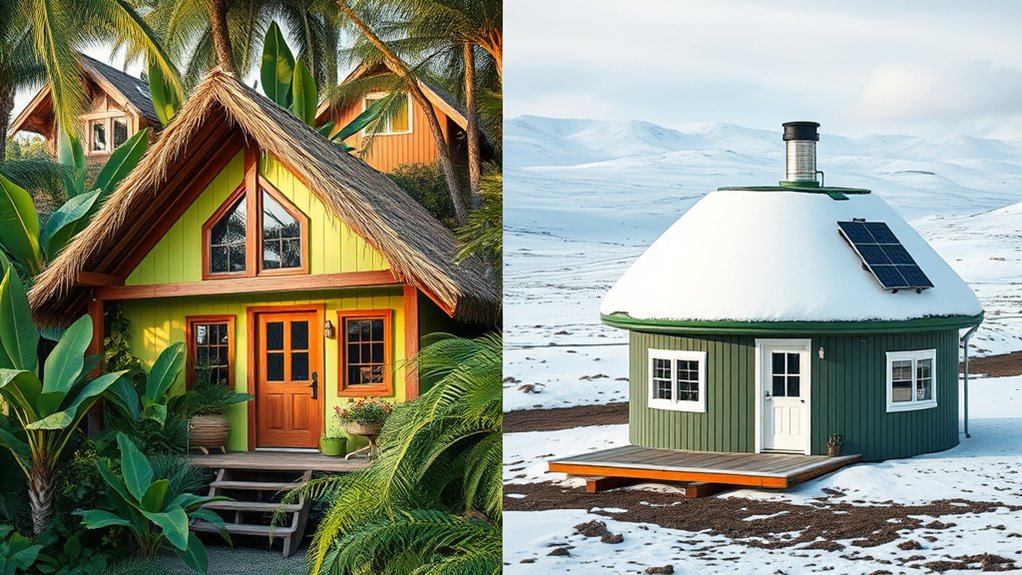
Maximizing energy efficiency in cold-climate tiny homes involves adopting a combination of insulation, sealing, and smart heating solutions. Use high R-value insulation in walls, floors, and roofs to minimize heat loss. Seal all gaps around windows, doors, and penetrations to prevent drafts. Incorporate thermal curtains and insulated window coverings to retain heat overnight. Choose heating systems like mini-split heat pumps, wood stoves, or radiant floor heating for maximum efficiency. The table below summarizes key strategies: Proper insulation significantly reduces the need for additional heating, conserving energy and lowering costs. | Insulation Materials | Heating Systems | Passive Strategies | |————————|—————–|——————–| | Sheep’s wool, cork, recycled denim | Mini-split, wood stove, propane | South-facing windows, thermal mass, solar panels | | Spray foam, high R-value | Radiant floors, electric, wood | Seal leaks, thermal curtains, direct sunlight. Additionally, implementing thermal bridging reduction techniques can further improve overall energy retention in tiny homes.
Optimizing Space and Layout for Tropical Living

Optimizing space and layout in tropical tiny homes requires thoughtful design choices that promote comfort and efficiency amid warm, humid conditions. You should choose narrow building forms to reduce heat gain and lower energy needs. Proper orientation is essential; align your home with prevailing winds to maximize natural ventilation and keep the interior cool. Incorporate large windows and skylights to harness natural light, reducing dependence on electric lighting. Use minimalist design principles to minimize clutter, making the space more livable. Maximize space with smart layouts and multi-functional furniture, ensuring every square foot serves a purpose. Additionally, plan outdoor living areas with weather-resistant furniture and native landscaping to extend your living space, enhance airflow, and create a relaxing environment. These strategies help you build a comfortable, sustainable tropical tiny home. Implementing passive design strategies can significantly improve indoor comfort and energy efficiency in tropical climates. Integrating climate-specific features such as shading devices and thermal mass can further optimize the interior environment by reducing heat transfer and maintaining a consistent indoor temperature.
Enhancing Comfort and Sustainability in Tundra Tiny Houses
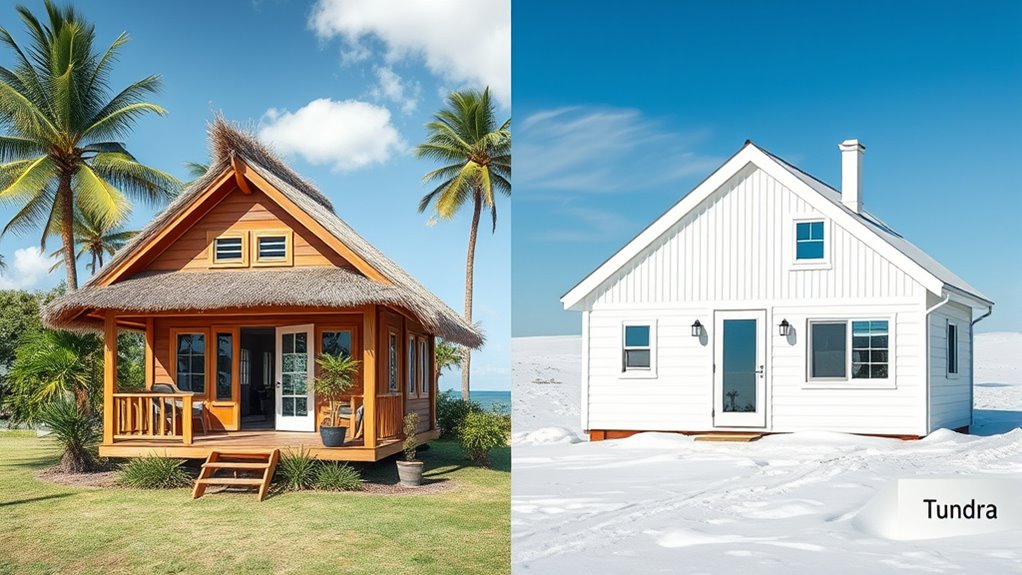
In harsh tundra climates, ensuring your tiny home stays warm and energy-efficient requires careful attention to insulation, structural design, and material choices. Use dense closed-cell spray foam insulation in walls and ceilings to maximize R-value and minimize heat loss. Opt for 2×6 or 2×4 framing combined with spray foam for durability and thermal performance. Incorporate vented roof systems to maintain airflow, reduce moisture, and prevent mold. Extended 8-inch overhangs protect exterior walls from snow and moisture. Inside, tongue and groove siding seals against drafts and resists warping. Build with robust, weather-resistant materials on stable foundations suited for frozen ground. Select high R-value insulation, energy-efficient windows, and heating options like wood stoves or propane systems. Proper foundation design is crucial in frozen ground to prevent shifting and damage, ensuring long-term stability. Additionally, exploring remote collaboration tools can facilitate consulting with experts on extreme climate adaptations. These choices keep your tiny house warm, sustainable, and resilient in extreme cold.
Lifestyle and Environmental Benefits of Climate-Specific Tiny Homes
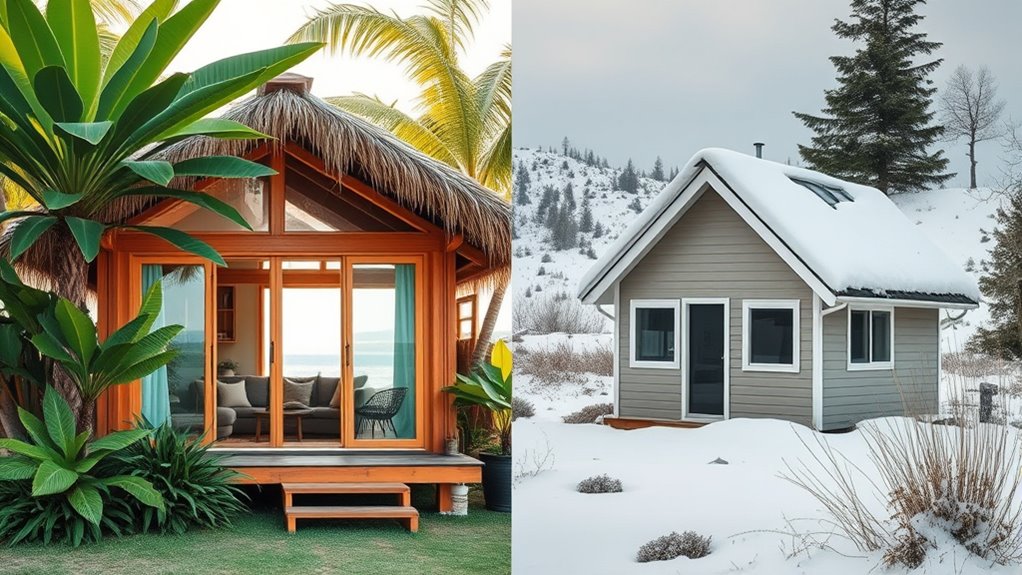
Climate-specific tiny homes offer numerous lifestyle and environmental benefits that make them an appealing housing choice. They adapt to different climates, enhancing comfort and livability, while also being more affordable to build and maintain. Their portability offers flexibility, allowing you to relocate easily without the constraints of traditional housing. Designed for energy efficiency, they reduce heating and cooling needs, lowering utility bills and environmental impact. Additionally, adopting a minimalist lifestyle encourages less consumption and waste, supporting sustainable living. Material efficiency and construction contribute to lower costs and environmental footprint.
- Adaptability to various climates for better comfort
- Cost-effective construction and maintenance
- Easy relocation with portability
- Maximal energy efficiency reduces resource use
- Promotes eco-friendly, minimalist living
Frequently Asked Questions
How Do Tiny Houses Adapt to Extreme Weather Fluctuations?
You adapt tiny houses to extreme weather fluctuations by incorporating flexible, resilient features. You use durable, impact-resistant materials for walls and roofs, ensuring they can handle wind, rain, or snow. You also design for insulation, sealing, and moisture control to maintain comfort. Additionally, you consider mobility or anchoring, allowing quick relocation or secure grounding during storms or temperature swings, keeping your tiny house safe and functional year-round.
What Maintenance Challenges Are Unique to Tropical Versus Tundra Environments?
You’re walking a tightrope when maintaining a home in extreme climates. In tropical environments, high humidity, pests, and mold threaten your tiny house like relentless storms, demanding constant vigilance and moisture-resistant materials. In the tundra, freezing temperatures, snow buildup, and shifting ground challenge your structures, requiring superior insulation and foundation checks. Each environment’s unique forces keep you on your toes, making maintenance an ongoing dance with nature’s unpredictable rhythm.
How Do Climate Differences Impact Tiny House Transportation and Installation?
Climate differences profoundly impact how you transport and install tiny houses. In tropical areas, you’ll face muddy roads, heavy rains, and humidity, requiring waterproofing and careful timing to avoid storms. In tundra regions, icy, frozen roads and extreme cold demand specialized vehicles, insulation, and frost-resistant foundations. You need to plan routes, choose suitable equipment, and adapt installation methods to weather conditions to guarantee safety and efficiency in both environments.
Are There Specific Local Regulations Affecting Tiny House Designs in These Climates?
You need to understand that local regulations considerably influence tiny house designs in different climates. In tropical areas, zoning laws and building codes require structures to withstand weather events like hurricanes and floods, often affecting foundation and material choices. In tundra regions, regulations emphasize insulation, frost protection, and structural stability for snow loads. These rules shape your design, ensuring safety, durability, and compliance with regional standards.
How Do Tiny Houses Promote Resilience Against Natural Disasters in Each Region?
You’ll find that tiny houses greatly boost disaster resilience, with 80% of communities reporting quicker recoveries. In tropical regions, they resist floods and storms by using lightweight, durable materials and elevating homes on stilts. In tundra areas, sturdy, well-insulated designs withstand freezing temperatures and heavy snow. Their mobility allows rapid relocation, making them essential for emergency responses. Overall, tiny houses offer flexible, affordable shelter that adapts to each region’s unique natural threats.
Conclusion
By designing tiny homes tailored to their climates, you create a sanctuary that feels as natural as a leaf in its environment. Tropical houses embrace breathable, sustainable materials for comfort, while tundra designs prioritize insulation and energy efficiency. Think of these homes as chameleons, adapting seamlessly to their surroundings. When you build with climate in mind, you not only enhance your comfort but also protect the environment—making your tiny home a true reflection of harmony with nature.
I’m Theodore, and I love tiny houses. In fact, I’m the author of Tiny House 43, a book about tiny houses that are also tree houses. I think they’re magical places where imaginations can run wild and adventures are just waiting to happen.
While tree houses are often associated with childhood, they can be the perfect adult retreat. They offer a cozy space to relax and unwind, surrounded by nature. And since they’re typically built on stilts or raised platforms, they offer stunning views that traditional homes simply can’t match.
If you’re looking for a unique and romantic getaway, a tree house tiny house might just be the perfect option.
